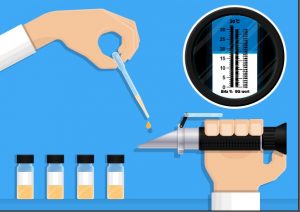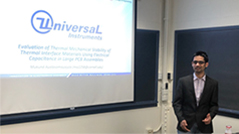Who is the AREA Consortium and what do they do?
Universal’s Advanced Research in Electronics Assembly (A.R.E.A.) Consortium is a member-driven organization whose purpose is to develop a deep understanding of the materials and processes utilized in electronics assembly through research and experimentation.
This research is conducted by the experienced team of scientists from the Advanced Process Lab (APL) who shares the results with more than 30 industry-leading member companies. The members collaboratively decide what technical areas should be pursued and what issues should be investigated. They also work with universities and government agencies to develop the industry awareness of their project results and to support their membership’s goals.
Each year, the APL, consortium members, and industry and academic researchers, choose a set of relevant projects on new and emerging technologies. The APL, utilizing its many years of broad-based expertise and extensive equipment portfolio, conducts analytical and experimental research on these topics in order to gain knowledge for specific product development and manufacturing processes and issues detailed reports on the results, which are shared with its members.
What are the Unique features of the A.R.E.A. Consortium?
- Our members actively collaborate to solve critical and emerging electronics industry challenges which are addressed in a real-world manufacturing capable lab!
- Because research is done in an actual manufacturing environment, we can deliver manufacturing relevant experimental results
- Our unique consortium model uses dedicated APL staff to conduct focused research which is fully staffed with experts. . . in a broad range of expertise; Ph.D./MS qualified research staff with diverse backgrounds across Mechanical, Chemical, and Materials Engineering disciplines
- We can do it all… with our vertically integrated capability from – design, manufacturing, characterization, and testing to analysis & reporting
What are the benefits/value of joining the Consortium?
- Collaborate with the other leaders in the electronics industry; our membership includes representatives from the Defense, Military/Aerospace, Medical, EMS, and more.
- Improve your competitive edge through collaborative research which enables cooperative R & D; and solve problems at the fraction of the time & cost
- Get exclusive member-only access – via a secure website link – to detailed project methodology, current and all past results, and recommendations enabling members to apply project deliverables to their specific area of interest.
- Get a leg-up on the latest information on state-of-the-art trends in electronics manufacturing
Interested in learning more, or want to participate in the A.R.E.A. Consortium?
- To learn more about everything membership in the consortium has to offer you by clicking here: Advanced Process Lab | Universal Instruments Corporation (uic.com)
- Or, reach out directly to Jim Wilcox, Manager, A.R.E.A. Consortium directly at jim.wilcox@uic.com
How can the Consortium help with new processes, materials, or aid in solving common problems?
- The members of the A.R.E.A. Consortium have their pulse on the electronics industry and are routinely exposed to new materials, processes, or common problems being faced. Their goal is to collaborative solve these problems, and or make recommendations on how to utilize these new materials or processes to address new or emerging market challenges. Below is a (fictional) customer case study on how becoming a member of the consortium could benefit you in this regard, and help you to build your best lollipop ever!
“There’s a New Sugar in Town: Build your Best Lollipop”
- Your customer Sweetmart has asked you to incorporate a new type of sugar called Sugarz into your lollipop manufacturing process. Sugarz contains pheromones which will naturally entice people to buy more lollipops. You’ve never worked with Sugarz and you’re not sure how to incorporate it into your manufacturing process. Some questions you might have. . . What are the risks if you use too much Sugarz? Do you need any special type of equipment? What is the melting point of Sugarz? What’s the right recipe?
- As a member of the A.R.E.A. Consortium, you confer with the other lollipop manufacturers such as Her-shi, Marz & Nestli, who are also concerned about the effects of using Sugarz. You collectively decide that the impact of utilizing Sugarz within the lollipop manufacturing process should be studied as a research topic, and it is approved.
- The APL (and their band of lollipop scientists and researchers), embarks on a detailed research project on Sugarz to determine what effects temperature and humidity would have on Sugarz and its pheromone properties.
- Chemical Engineer, Terry Sweet (M.S.), and Ph.D. student John Sour are assigned to the project and spend three months doing extensive research on Sugarz utilizing the full range of equipment in the APL’s lab as well as their broad-based expertise. They produce lollipops and place them into selected environmental chambers to determine the impact of heat and cold. They expose the lollipops to drop testing to determine the point of breakage, and also what factors impact the breaking point?
- They make many different types of lollipops, using different manufacturing equipment, processes, and ingredients – or recipes. They put the lollipops through rigorous testing, and document and review the results each step of the way. They create slices of the different recipes (cross-sections) and analyze them using their very high-resolution electron microscope allowing them to see the lollipops underlying structure.
- During a chemical analysis, when they saw a spike in pheromones occurring, they consulted Dr. Candy Bowl – a Professor of Chemical Engineering at Goodbar University – and just one of the members of academia the consortium has access to. As this was his area of expertise, Dr. Bowl was able to determine why the pheromones were spiking and made recommendations on ways to fix the problem, which they tested and implemented.

Documentation. . . each step of the way!
Each step of the lollipop manufacturing process utilizing Sugarz was thoroughly tested and carefully documented in our real-world manufacturing environment. {This means that the processes and material utilized can immediately be transferred to a live manufacturing process.}
- At the end of this project, the detailed results of the Sugarz research project were presented at the A.R.E.A. Consortium quarterly meeting – everything you wanted to know about Sugarz from – temperature sensitively, chemical breakdown, as well as manufacturing process steps are revealed. You now have access to the information needed to integrate Sugarz into your lollipop manufacturing process.
- The results: After 6 months, you replace sugar with Sugarz, and your first batch of lollipops rolls off the line. People love them and can’t get enough and they fly off the shelves. And as a result, your customer, Sweetmart, increases their lollipop order by an additional 30%, which adds profit to your bottom line!
Because of the collaborative R&D provided by your membership in the Consortium you were able to integrate Sugarz into your manufacturing process at a fraction of the cost & time if you were to undertake this on your own!
- Ultimately, membership in the A.R.E.A. Consortium enabled you to build your best lollipop ever and resulted in a win-win for both you and your customer. It also ensured that you now have access to cutting-edge research into any new ingredients, materials or processes, coming onto the market allowing you to stay one step ahead of the competition!
Now, imagine what membership in the A.R.E.A. Consortium could do for you IRL (in real life)!











